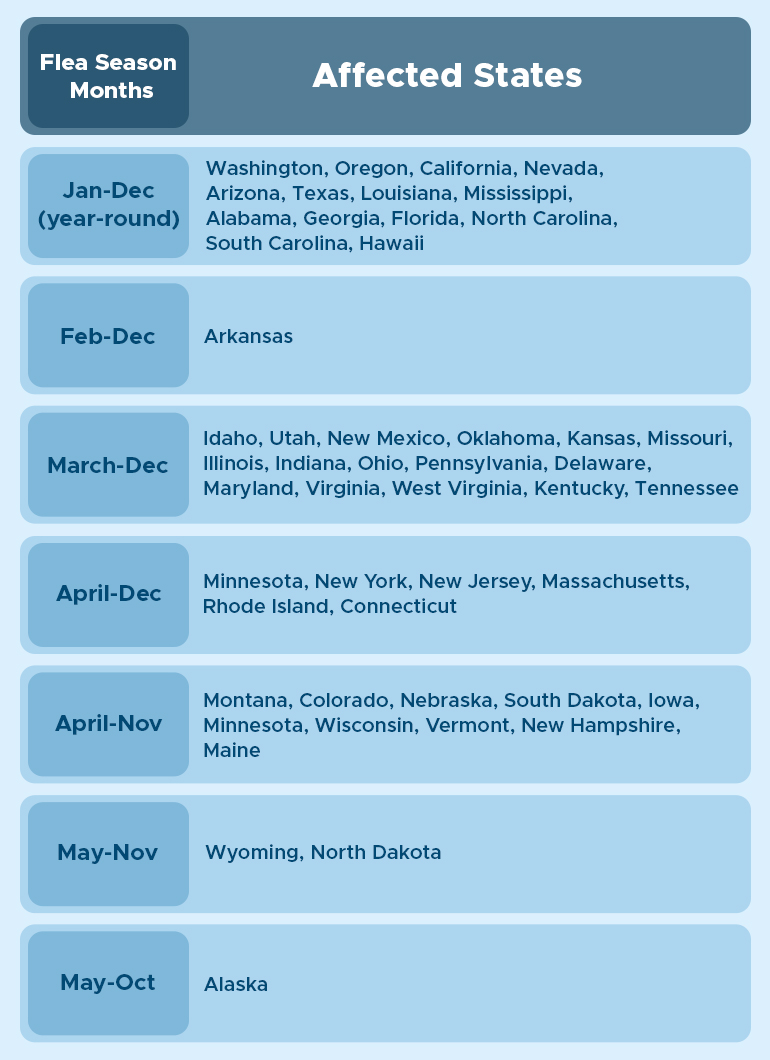[ad_1]
Come summer and all pet parents start worrying about flea and tick infestations in their furry friends. But, are our pets protected from these blood-sucking pests in seasons other than summer? Or, do fleas stay active during the same period across all geographical regions? The answer is a big NO!
Check out this blog to learn about flea tendencies, how you can stay well-prepared to save your pet from these parasites, and some of the common misconceptions about flea infestations in pets.
Peak Flea Activity Season
The warm and humid temperature suits fleas the most. That is why; fleas stay the most active during spring, summer and early fall in the majority of states. However, fleas are one of the most stubborn creatures with a strong survival instinct. Flea pupae can stay dormant inside their cocoons during the unfavorable cold weather until the warmer months approach and they find a host to thrive on.
State-wise Idea of Flea Activity Season
As soon as the chilly winter gets over and a comparatively warmer spring season starts, fleas come out of their dormant state, find a host in your beloved four-legged friend, and start to spread the infestation. The duration for which fleas stay active, however, depends on the part of the country you live in. Here is a state-wise guide to get an idea about the duration of flea season in different regions of the United States:

Jan-Dec (year-round)
- Washington
- Oregon
- California
- Nevada
- Arizona
- Texas
- Louisiana
- Mississippi
- Alabama
- Georgia
- Florida
- North Carolina
- South Carolina
- Hawaii
Feb-Dec Month
March-Dec Month
- Idaho
- Utah
- New Mexico
- Oklahoma
- Kansas Missouri
- Illinois
- Indiana
- Ohio
- Pennsylvania
- Delaware
- Maryland
- Virginia
- West Virginia
- Kentucky
- Tennessee
April-Dec Month
- Minnesota
- New York
- New Jersey
- Massachusetts
- Rhode Island
- Connecticut
April-Nov Month
- Montana
- Colorado
- Nebraska
- South Dakota
- Iowa
- Minnesota
- Wisconsin
- Vermont
- New Hampshire
- Maine
May-Nov Month
May-Oct Month
Warm and humid weather suits ticks as well. Therefore, tick season more or less coincides with flea season. Learn more about tick season in the USA here.
Can fleas bear heat?
Though fleas flourish in warmer temperatures, they cannot survive in extreme heat. Long periods of dry, hot weather are not suitable for them. Fleas can nonetheless find refuge in shaded areas, mats, carpets, beds, and all the cooler places your pet uses during the heat wave, and come out of the dormant state once the weather is more suitable.
Protecting Your Pet from Flea Infestation
Flea infestations, when neglected, can lead to severe health problems for your dog or cat. That is why, it is better to protect them from the attack of these pesky parasites to the extent possible and treat the infestations immediately upon detection. Taking the following measures can spare you and your furry companion from trouble:
- Examine your pet thoroughly after every outdoor exposure to find out whether any fleas have hopped onto them.
- Be vigilant. If you find your pet chewing or licking their fur incessantly, it could be due to the irritation of flea bites. Go for flea treatment immediately.
- Opt for year-round flea and tick treatment and preventive for your pet, no matter which part of the country you live in. Various oral treatments like chewables and tablets, and topical treatments like spot-ons, sprays, shampoos and collars are available on the market.
- Talk to your pet’s veterinarian, and administer their suggested flea and tick treatments and preventives to your pet regularly.
[Also Read] From Topical to Flea Pills for Dogs – Which One Is Right For Your Dog?
Flea Infestations & the Myths
Here are some of the most common misconceptions regarding flea infestations in pets and the reality behind them:
1. Myth: Flea infestations are to be taken care of only in the summer
Fact: Fleas, as stated above, can survive even the harsh cold weather by staying dormant. During winter months too, if there are intermittent warmer periods, fleas can become active resulting in surprise infestations in your pet. It is therefore necessary to keep your pet on year-round flea preventives.
2. Myth: If only one flea is visible, there will not be more
Fact: As soon as they take their first feed, female fleas are ready to lay eggs. A female flea can bite 400 times and lay around 50 eggs in a single day, some of which can fall off your pet’s body and spread onto carpet resulting in future infestations. A single flea can thus lead to a severe flea infestation in your pet even before you notice it.
3. Myth: All fleas can be treated at once
Fact: As fleas can lay dormant for a long time, getting rid of all of them at a go is difficult. Going for a regular dose of flea treatment and being alert regarding flea presence by checking your pet regularly can help keep these nasty parasites away from your fur baby.
To Conclude
Flea and tick infestations are a common yet worrisome problem seen in pets. Although fleas thrive the most during the summer season, they are not completely ineffective during other parts of the year. Care must be taken all year round to keep your pet protected from the attacks of these menacing parasites.
[ad_2]
Source link
